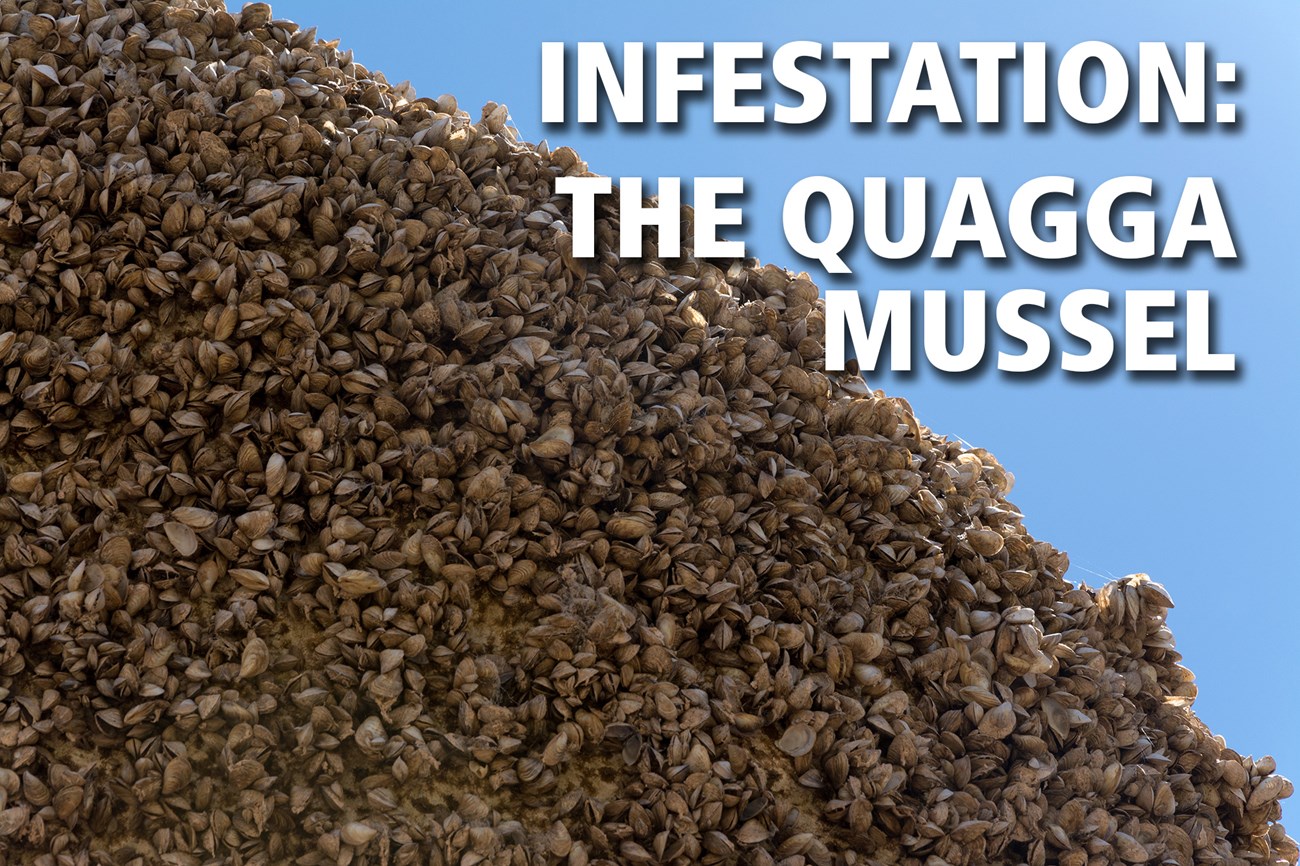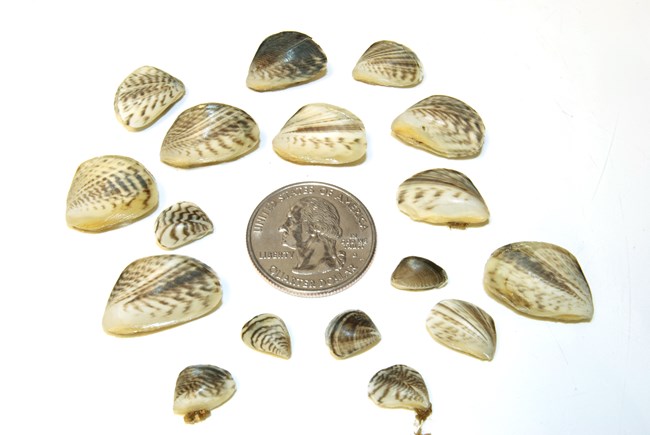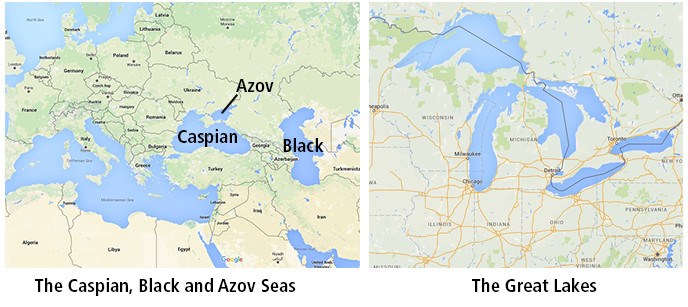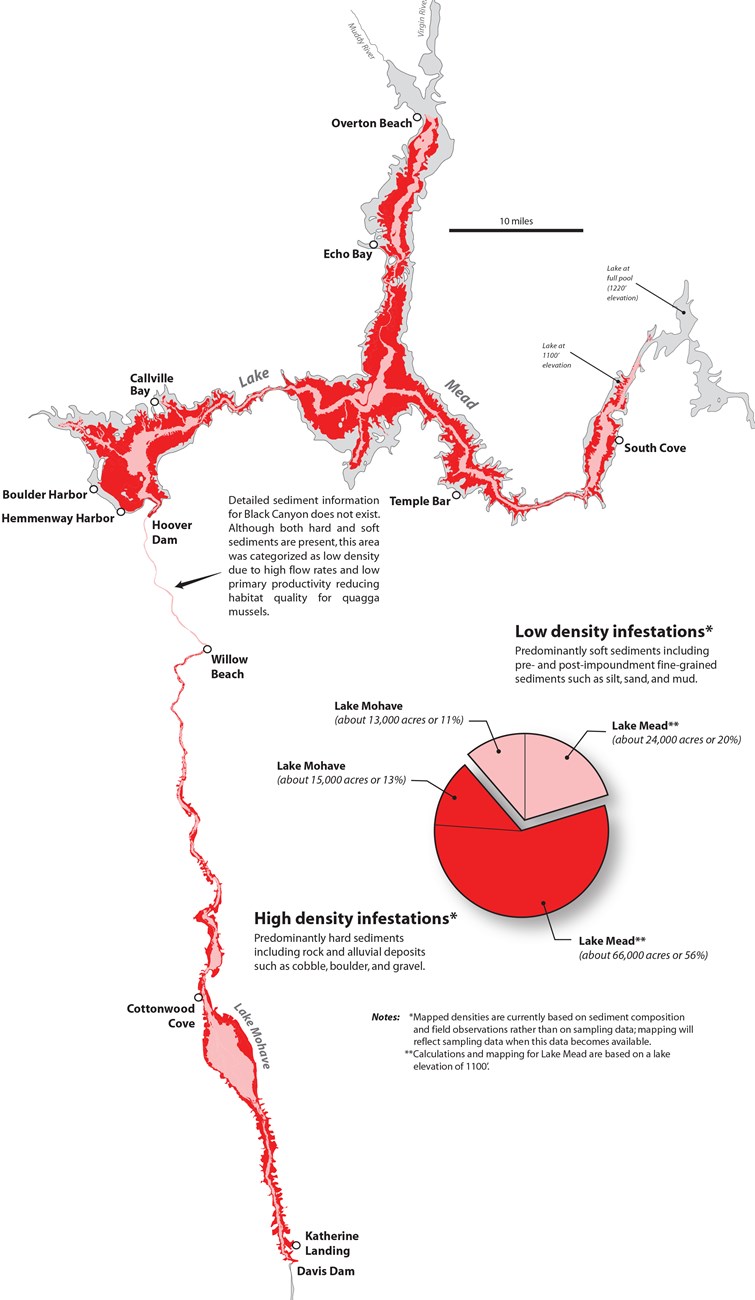
Photo: Andrew Cattoir
Invasive species, land or water based, is an ongoing concern for wildlife biologists and park visitors alike. The Lake Mead National Recreation Area (NRA) is not immune and in 2007 it was discovered that the quagga mussel had infiltrated the lake at Las Vegas Boat Harbor. Since the initial sighting, the quagga mussel has spread to most parts of lakes Mead and Mohave, causing concern for boaters and water based equipment like water buoys, underwater archeological sites and structures. The dollar figure estimate for damage caused by quagga mussels has the potential to cost millions of dollars in repairs and reconstruction if not controlled.
Shells of dead mussels are hazardous to people on beaches and larval mussels, called veligers, are drawn into boat engines and bilges where they grow into adults and clog recreational equipment. Mussels feed by continuously filtering water for plankton, and the tremendous filtering capacity of large colonies of mussels can deprive other aquatic species of resources necessary for survival. It also causes irreversible ecosystem changes and losses of both native species and sport fisheries.

What Are They? Quagga mussels are native to the Caspian, Black and Azov seas of Eastern Europe. This exotic species was first discovered in the U.S. in Lake Saint Clair, Michigan in 1988 and is believed to have been introduced in 1986 through ballast water discharged from ocean-going ships. Since their initial discovery, quagga mussels have spread rapidly throughout the Great Lakes and Mississippi River Basin states and other watersheds throughout the eastern and central U.S.
The United States has been invaded by two species of freshwater mussels. Their common names are zebra mussel (Dreissena polymorpha) and quagga mussel (Dreissena bugensis.) Both are small, freshwater bivalve mollusks, relatives of clams and oysters, which are triangular in shape with an obvious ridge between the side and bottom. Lake Mead NRA is currently infested with the quagga mussel, not the zebra mussel. The quagga mussel has been called the zebra mussel's "evil" cousin because it is much more prolific and can survive from the water's surface down to 500 ft.
Quagga mussels are primarily plankton feeders. They can filter out phytoplankton and zooplankton, the microscopic plants and animals that form the base of the food web. Effects of their huge appetite on the zooplankton that feed on the phytoplankton and the shad and juvenile fish that feed on the zooplankton are not yet understood. However, these invasive mussels are essentially taking from the food supply of two trophic levels.
Quagga mussels have very few natural predators in North America, but it has been documented that several species of fish and diving ducks eat them in limited quantities. In all cases, predators of the mussel have either directly experienced or indirectly caused negative outcomes by bringing these into the food chain. The round goby, one of their predators in the Great Lakes, is highly invasive. Although it will eat the mussels, this fish does not keep mussel populations under control and has negatively impacted the ecosystem of the Great Lakes. We are not aware of any predators capable of inhibiting mussel growth in the Colorado River.

Maps Courtesy Google Maps How Did They Get Here? We may never know where the initial Colorado River infestation occurred. Before they spread to the California Aqueduct, the quagga mussels in the Colorado River were about 1,000 miles farther west than any other recorded findings. The primary method of overland dispersal by quagga mussels is through human-related activities. Given their ability to attach to hard surfaces and survive out of water, many infestations have occurred by adults hitching rides on watercraft. The microscopic larvae also can be transported in bilges, ballast water, live wells, thru-hull fittings or any other equipment that holds water. They have been found on non-watercraft objects that simply came in contact with mussel-infested water.
What is Being Done?
Lake Mead NRA developed an immediate and comprehensive response. This invasive organism is known to significantly alter aquatic ecosystems and impact water-based facilities. The National Park Service is committed to preventing the spread, slowing the rate of infestation and determining treatment options to minimize the threat posed by this species to currently infested waters.
Once quagga mussels have been established in a water body, there is no economically feasible method of eradication. Preventing spread remains our best course of action. Since quagga mussels have planktonic (free drifting) larvae, preventing spread to water bodies downstream from known infestations may not be possible. However, westward, over land spread is assumed to be largely due to trailered boat traffic. Thus, farther westward spread of quagga mussels is highly preventable.
The best prevention tool is the proper cleaning and drying of boats, trailers and equipment. Federal, state and private agencies are updating and coordinating public information and policies to develop the most effective prevention measures. These entities will continue meeting to develop management and information plans to help the boating public prevent infestation to other water bodies.
What Kind of Monitoring is Lake Mead NRA Doing on the Mussels? Some of the current studies on the quagga mussel include: 1. Age and Growth Analysis2. Larval Monitoring
3. Presence/Absence on artificial substrates
4. Permanent Transects to examine colonization and density 3
5. Temperature Tolerance Tests
6. Studies on Promising Methods on Eradication of Mussels (still in the testing stage)
7. Toxic Concentration Level Analysis on Mussel Tissue
Depending on the substrate, quagga mussels will attach at different rates. They are growing on a variety of substrates including duct tape, rope, aluminum, brass, steel, stainless steel, fiberglass, plastic, leather, old antifouling paint, ABS plastic, PVC, etc. Thus far, there is no color or substrate they will not attach to other than effective antifouling paint. We are currently developing recommendations and best management practices for watercraft users at Lake Mead NRA.

What Can I Do?
It is up to each of us to take extra precautions to stop the spread of quagga mussels or any other invasive species. The following actions should be taken with any equipment used in potentially infested waters:
All equipment (e.g., dive gear, boats, trailers, motors, fishing tackle, etc.) should be visually and tactically (by feel) inspected for the presence of quagga mussels prior to and after use in any water body. Objects such as life jackets, seat cushions, rope and fishing bobbers may foster mussel growth. Additionally, any vegetation or mud attached to this equipment must be removed and left at the site of origin.
Effective ways boaters (including personal watercraft, canoe, kayak and fisherman float tube users) and fisherman can ensure that their boats, vehicles, trailers and other equipment do not become the means of infecting other waters are listed below.
1. When using any equipment (motorized, unmotorized, fishing gear, dive gear, kayaks, boating gear) within Lake Mead NRA's quagga-infested waters, we strongly recommend the following precautions be taken. When taking your equipment out of the water:
• Drain the water from your motor, live well and bilge on land before leaving the immediate area of the lake.
• Oily or dirty bilge water must be contained and disposed of properly. Ask the closest marina if in doubt of proper disposal location. • Towel down any areas with standing water. Check all storage areas (anchor/line lockers).
• Do not reuse bait once it has been in the water. If bait was not obtained from the lake, discard in trash.
• Completely inspect your vessel and trailer, removing any visible mussels, but also feel for any rough or gritty spots on the hull. These may be young mussels that can be hard to see.
2. If you are planning on launching at another body of water or taking your boat out of state:
• Wash the hull, external areas of motor, and any other exposed surface with hot, pressurized water (=140°).
• Alert the trained staff to areas of your boat that you know may hold water or may foster animal or plant growth. Work with them to ensure that your boat has been cleaned as thoroughly as possible
• In addition to the above cleaning, Callville Bay and Katherine’s Landing have the capabilities to flush the coolant system, gimbal area and bilges with hot water (=140°).
• Clean and wash trailer, truck or any other equipment that comes in contact with lake water. Mussels can live in small pockets anywhere water collects.
• Be sure that you have received two documents: your receipt and a Watercraft Inspection and Decontamination Report. Take these with you when you cross state line.
• Before leaving to cross state line or enter another water body, check boat and trailer for vegetation or mussels. Dead mussels may have become detached from tight, small areas. Remove anything visible. Remember, you could be cited for transporting mussels, even if they are dead.
When You Return Home:
• Air-dry the boat and other equipment for at least five days before launching in any other waterway.
• Damp, cool weather with adult mussels/dry boat/equipment for 30-45 days
• Damp, cool weather with veligers/settlers?dry boat/equipment for 10-15 days
• In southern Nevada under normal seasonal conditions, drying time for summer and winter season is recommended at 5 and 15 days, respectively.
• Allow all fishing tackle to air dry for 5 days before fishing in other lakes and streams.
3. If you rent a boat slip in the park and you are planning on taking your boat on a trailer outside of Lake Mead NRA, you are required, as is stipulated in your slip rental agreement, to decontaminate at a wash station within the park boundary. Call your nearest marina and schedule an appointment for a vessel inspection and decontamination.
|
Last updated: February 11, 2019
